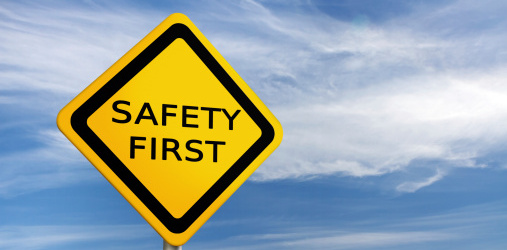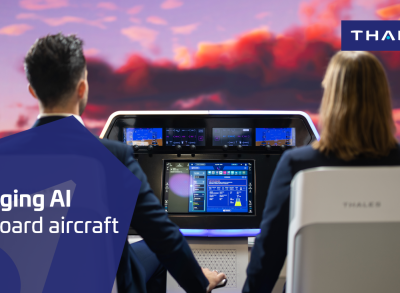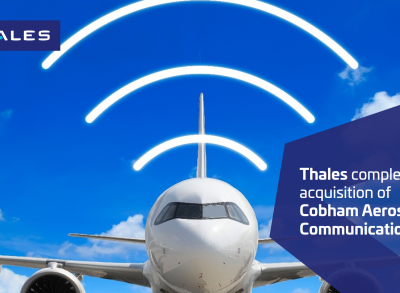Making flying safer in a world with new challenges
Thales Avionics technical director Bruno Nouzille looks at the new challenges facing the aerospace sector and tells us what Thales is doing to address them.

Flying is safe and getting safer all the time. The accident rate has dropped by a factor of five in the last 20 years, standing today at 1 fatal passenger flight accident per 5 million flights. The aviation industry is now looking to do even better, aiming at a rate of 1 fatal accident per 10 million flights by 2050, despite new challenges.
What new risks are there?
They’re tied to increasing air traffic and growing system complexity. Over the last 15 years, the number of flights has risen by roughly 4.6% a year, which makes air traffic and airport operations harder to manage. Aircraft flight systems demand much more computing power; sensors and systems are ever-more complex, so the potential for technical failure or human error increases.
The risks fall into three basic categories: technical and equipment failures, human errors — or to be more precise, errors made when the crew is interacting with flight systems — and malicious acts.
The aviation industry as a whole is working to mitigate these risks. And Thales is naturally at the forefront, because safety and security are our core businesses in all of our markets.
How is the aviation industry tackling these new risks?
Safety remains the industry’s number one priority and it’s doing everything it can to counter all known threats. For technical failures, this means highly detailed failure and criticality analyses, and increasingly stringent standards and regulations. For human error, the focus is on training and human machine interface with a view to maintaining a crew-centric approach to aircraft systems. Lastly, governments are tightening security against cyber and physical attacks and defining joint standards and regulations.
What role is Thales playing?
Thales is involved at several levels on account of its expertise in avionics, air traffic management and cybersecurity. Inside the aircraft, we’re working to develop a more human-centric cockpit with intuitive user experiences, which we design with pilots so that flight crews have a clearer picture of the aircraft’s status and trajectory at all times, including during stressful situations.
Head-up displays (HUDs) are set to play a more prominent role in sharing of information directly useable by the crew. Research shows that such systems are a key aid in flight safely. Thales’s background in this area goes back to the 1950s and HUDs have been used to a moderate degree in civil aviation since the 1990s, but demand is burgeoning today, not least because they are now required by the air transport safety authorities of some countries including China.
The natural extension of HUD is the Head Worn Device (HMD) that overlays flight and navigation symbology on a real or synthetic picture of the outside world, thus broadening the crew’s field of view up to 360° and providing a permanent display of critical information. Our TopMax solution is a good example that allows pilots to better anticipate events and fly the aircraft more intuitively.
Can you tell us a bit more about managing aircraft trajectories?
Our ‘fly-by-trajectory’ concept is a new, enhanced trajectory management system that aims to provide the crew with a permanent display of the trajectory while enabling them to look ahead and control it simply and directly. Today, the flight management system (FMS) calculates an overall trajectory and automatically guides the aircraft through the autopilot along that trajectory. Our idea is to overlay the precise future trajectory on top of the real landscape on the HUD or on the HMD, or on a synthetic picture on head-down displays (HDDs). The pilot would then be able to control this trajectory manually with expanded safety and protection functions.
Modern aircraft are increasingly connected. What risks come with these technologies?
There aren't only risks involved — increased connectivity also brings major safety benefits. Today, aircraft are connected via satcom, Gatelink, ATG and other systems, which enhance safety by giving us their position and status at all times.
This connectivity also increases efficiency by making it possible to optimise a flight using real-time data received from the ground or other aircraft.
And of course connectivity enhances the flight experience for passengers as they can use their personal devices to stay in touch or interact with the open world via the aircraft’s IFEC system.
But it also means that cybersecurity is becoming an even bigger safety consideration in the aerospace industry. A comprehensive approach to cyber threats is essential. The aerospace community is well aware of this issue and the industry and regulatory authorities in France, Europe and worldwide are gearing up accordingly.
The goals are to improve our knowledge of cyber threats and how they are evolving, guarantee the robustness, resilience and protection of aircraft information systems, assure that aeronautical systems can respond and be restored in the event of a cyberattack. We need to constantly develop a culture of cybersecurity and make sure it is taken into account at every level.
Thales has an almost unique role to play in this respect. We are a key player in cybersecurity being for example the world number one in financial security, responsible for managing 80% of transactions worldwide. We have more than 1,500 cyber-experts in 50 countries and a wealth of experience in both the civil and military markets. So we have a clear role to play in onboard cybersecurity. Thales is also the only company owning threats surveillance capacity with both its CERT (computer emergency response team) and its ANSSI ITSEF certified lab ( information technology security evaluation facility .
Find us on Twitter @thales_avionics, on our official Youtube channel Onboard TV and on LinkedIn Thales Aerospace.




